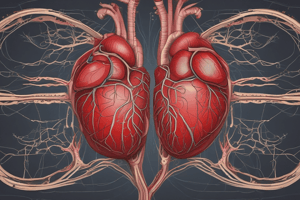Podcast
Questions and Answers
What is the function of the Aorta?
What is the function of the Aorta?
- Supply oxygen to the heart
- Attach to the heart chambers
- Transport blood from the heart to the rest of the body (correct)
- Transport blood to the lungs
Which veins carry blood to the right atrium of the heart?
Which veins carry blood to the right atrium of the heart?
- Superior Vena Cava (correct)
- Pulmonary veins
- Aorta
- Inferior Vena Cava (correct)
What do the right and left pulmonary arteries do?
What do the right and left pulmonary arteries do?
Direct blood to the corresponding lung
Why are there two pulmonary arteries?
Why are there two pulmonary arteries?
What is the role of the right and left pulmonary veins?
What is the role of the right and left pulmonary veins?
What is the function of the pulmonary arteries and veins?
What is the function of the pulmonary arteries and veins?
What does the pulmonary trunk do?
What does the pulmonary trunk do?
What is the function of the right and left ventricles?
What is the function of the right and left ventricles?
What is the septum in the heart?
What is the septum in the heart?
What is the function of the tricuspid valve?
What is the function of the tricuspid valve?
What does the bicuspid valve do?
What does the bicuspid valve do?
What are chordae tendineae?
What are chordae tendineae?
Flashcards are hidden until you start studying
Study Notes
Aorta
- Main artery of the body, carrying oxygenated blood from the heart to the rest of the body.
- Distributes blood to smaller arteries supplying limbs and organs, excluding the lungs.
Superior & Inferior Vena Cava
- Two large veins transporting deoxygenated blood to the right atrium.
- Superior vena cava gathers blood from the brain and upper limbs.
- Inferior vena cava, the largest vein, drains blood from the trunk and lower limbs.
Right and Left Pulmonary Arteries
- Branch from the pulmonary trunk, directing deoxygenated blood to corresponding lungs.
Function of Pulmonary Arteries
- Carry deoxygenated blood from the right ventricle to the lungs for oxygenation.
- Distinct from bronchial arteries, which supply nutrients to lung tissue.
Right and Left Pulmonary Veins
- Responsible for returning oxygenated blood from the lungs to the left atrium.
- Unique among veins for carrying oxygenated blood instead of deoxygenated.
Function of Pulmonary Arteries and Veins
- Pulmonary arteries transport deoxygenated blood to lungs; pulmonary veins bring oxygenated blood back to the heart.
Pulmonary Trunk
- Major vessel originating from the right ventricle, bifurcating into the right and left pulmonary arteries.
Function of the Pulmonary Trunk
- Serves as a conduit for deoxygenated blood from the heart to the lungs for purification and oxygenation.
Right and Left Atria
- Blood enters heart via atria; deoxygenated blood enters the right atrium from vena cavas.
- Right atrium pumps blood into the pulmonary circuit.
Right and Left Ventricles
- Right ventricle pumps deoxygenated blood to lungs through the pulmonary artery.
- Left ventricle, the thickest chamber, pumps oxygenated blood to the body.
Function of Right and Left Ventricles
- Right ventricle sends blood to the lungs; left ventricle supplies body tissues with oxygenated blood.
Septum
- Divides heart into right and left sides, consisting of atrial (between atria) and ventricular (between ventricles) septa.
Tricuspid Valve
- Located between the right atrium and right ventricle; prevents backflow of blood into the right atrium.
Bicuspid (Mitral) Valve
- Ensures unidirectional blood flow; improper closure can lead to backflow into atria from ventricles.
Chordae Tendineae
- Attach to papillary muscles in ventricles, aiding in the function of atrioventricular valves to prevent backflow.
Studying That Suits You
Use AI to generate personalized quizzes and flashcards to suit your learning preferences.





